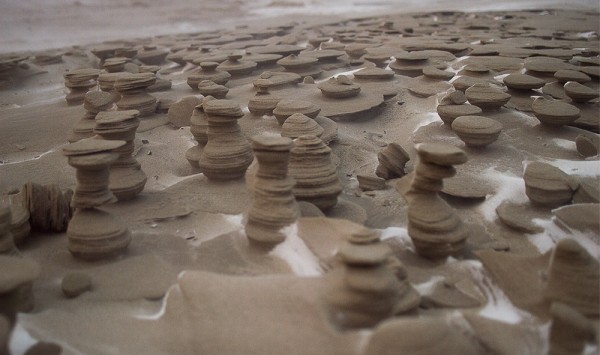It may have been the hottest recorded winter in 134 years, but much of the American Northeast endured freezing temperatures early this year, largely owing to a Polar Vortex that pushed seasonal sheets of ice across the Great Lakes in the Midwest. After an early spring, the ice has begun to clear away, and for a brief period, the waters of Lake Michigan are clear enough to see the shipwrecks lying beneath its surface – so large that they are visible from the air.
The U.S. Coast Guard Air Station of Traverse City, Michigan, reported crystal clear water conditions and the sighting of these lost ships while conducting a routine patrol of the area. Last week, a handful of aerial photos were uploaded on their Facebook page. These images were taken of an area near Sleeping Bear Point which is known as the Manitou Passage Underwater Preserve. According to the preserve’s website, this are is “one of the richest areas in Michigan for shipwreck diving.”
The idea of diving for shipwrecks in a lake might seem unusual, but in fact there’s quite a few lost ships buried beneath the lake, some of which date back a few centuries. Local treasure hunters claim to have found a lost ship belonging to 17th century French explorer Robert LaSalle, but have yet to verify if the ship they videotaped is in fact four centuries old. The season is somewhat short lived, as warmer weather leads to algal blooms, which will again make the water difficult to see through.
So why do so many appear around the Manitou Passage – an area lying just north of the North and South Manitou Islands, both of which act as a type of barrier that protect ships in the area from potential storms. The growing lumber trade in the Great Lakes region by the mid-19th century turned the Manitou Passage into an important waterway, and that’s about the time that one of the newly sighted ships dates back to.
Susan Cosier, who writes for the journal On Earth, has reported on the latest finds:
“Not much is known about most of the wrecks, but they do include one doomed vessel, the James McBride, which was thought to be the first to carry cargo from the Atlantic Ocean to Lake Michigan in 1848. Facebook commenters helped fill in some of the blanks, but most the historic details are still, well, watery.”
The Coast Guard Air Station has tacked on any information people were able to accumulate either from common knowledge or off of the Internet in the captions for each of the images. Out of the five sighted ships that they posted pictures of, there are still three that remain unidentified.
Bill Chappell, a reporter from NPR.Org has noted that sighting these wrecks from in the air is a “fairly common” occurrence, as he was told by one of the patrolling pilots, Lieutenant Commander Charlie Wilson, but this is an unusual case, because typically the number of wrecks is generally “not in the numbers we saw on that flight.” Chappell also interviewed workers at the Michigan Department of Environmental Quality who noted: “An estimated 6,000 vessels were lost on the Great Lakes with approximately 1,500 of these ships located in Michigan waters.”
Other wrecks so far investigated within the Manitou Passage include the more modern vessel The Francisco Morazan, which was an ocean-going freighter hurtled aground during one particularly rough snowstorm on November 29, 1960. The Morazan actually shipwrecked directly on top of another ship over half a century older: a wooden steamer called the Walter L. Frost, which disappeared on November 4, 1903. Both of these wrecks took place in shallow water, only a few hundred yards away from the shore, according to the preserve’s website.
Agricultural runoff near the area causes algal blooms that become more prevalent with warmer temperatures. Therefore, these particularly views are rare, as the lake will soon be covered over. The vessel pictured is the Rising Sun, which sank on October 29, 1917, after all 32 passengers on board were successfully rescued.
|
James Sullivan
James Sullivan is the assistant editor of Brain World Magazine and a contributor to Truth Is Cool and OMNI Reboot. He can usually be found on TVTropes or RationalWiki when not exploiting life and science stories for another blog article. |



